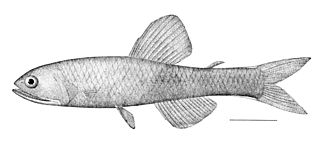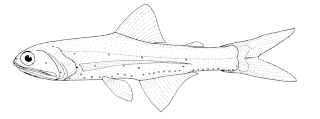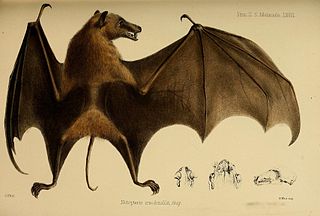
Lampanyctus is a genus of lanternfishes.

The southern lanternfish, Lampanyctus australis, is a lanternfish of the family Myctophidae, found circumglobally in the southern hemisphere between 33° S and 44° S, mainly at below 500 m. Its length is about 13 cm. It is an oceanic mesopelagic species, eaten by hakes, kingklip and Cape horse mackerel.

The totoaba or totuava is a species of marine fish, a very large member of the drum family Sciaenidae that is endemic to the Gulf of California in Mexico. It is the only species in the genus Totoaba. Formerly abundant and subject to an intensive fishery, the totoaba has become rare, and is listed on CITES Appendix I, as critically endangered on the IUCN Red List, and as 'endangered' under the Endangered Species Act.

The Hood mockingbird, also known as the Española mockingbird, is a species of bird in the family Mimidae. It is endemic to Española Island in the Galápagos Islands, Ecuador, and it is one of four closely related mockingbird species endemic to the Galápagos archipelago. It is found in dry forests and is omnivorous, though it primarily is a carnivore or scavenger. The species has a highly territorial social structure and has no fear of humans. It is the only species of Galápagos mockingbird that Charles Darwin did not see or collect on the voyage of the Beagle.

The long-tailed fruit bat, long-tailed blossom bat, or Fijian blossom bat is a species of megabat in the family Pteropodidae. It is found in Fiji and Vanuatu. They roost as large colonies in caves and forage in a range of lowland and montane habitats. It is threatened by exploitation and disturbance of its roosting caves, hunting, and tourism.

Notopteris is a genus of megabat in the family Pteropodidae. It contains the following species:

Otarocyon is an extinct genus of the Borophaginae subfamily of canids native to North America. Ot lived during the Oligocene epoch, about 33.3—20.6 Ma. Fossils have been found only in Montana, Wyoming, and South Dakota.
Lampanyctus acanthurus is a species of lanternfish.

Lampanyctus alatus is a species of lanternfish. It is found in parts of the Atlantic, Indian, and Pacific Oceans. It grows to 6.1 cm (2.4 in) standard length.
Lampanyctus festivus is a species of lanternfish. It is found in the Atlantic, Indian, and Pacific Oceans. It is a mesopelagic fish that undertakes diel vertical migration. It grows to about 14 cm (5.5 in) standard length. It is an important component in the diet of forkbeard Phycis phycis off the Azores.
Lampanyctus hubbsi is a species of lanternfish.
Lampanyctus intricarius is a species of lanternfish.
Lampanyctus iselinoides is a species of lanternfish.
Lampanyctus jordani is a species of lanternfish.
Lampanyctus lepidolychnus is a species of lanternfish.
Lampanyctus macropterus is a species of lanternfish.
Lampanyctus nobilis, the noble lampfish, is a species of lanternfish.
Lampanyctus pusillus is a species of lanternfish.
Lampanyctus turneri is a species of lanternfish. It is found in the Indian and western Pacific Oceans. It grows to 7 cm (2.8 in) standard length.
Lampanyctus vadulus is a species of lanternfish.







